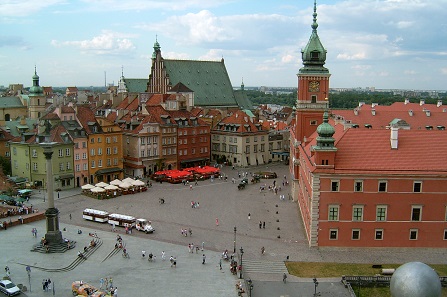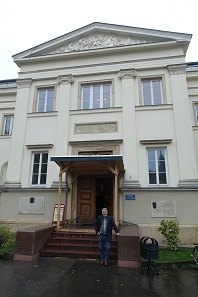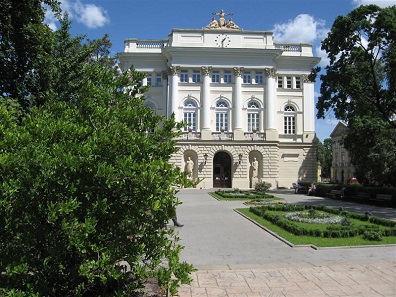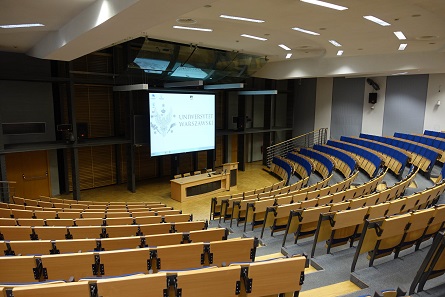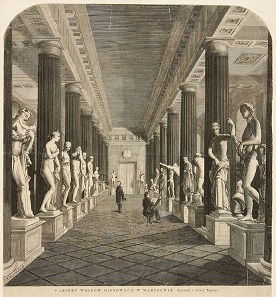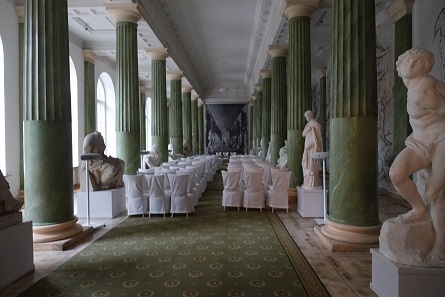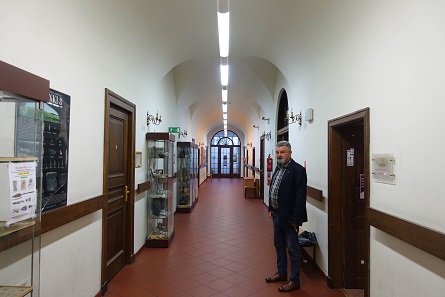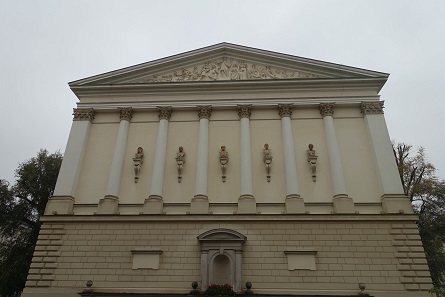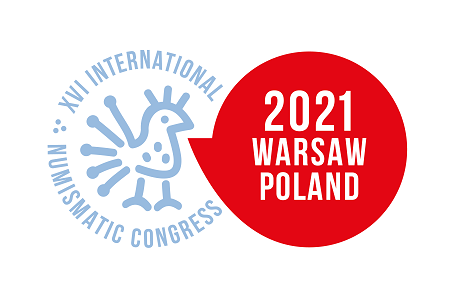by Ursula Kampmann
translated by Christina Schlögl
June 7, 2018 – First of all: I have done a lot of travelling in my life. But if I had to give an award to the most hospitable and welcoming nation in the world, Poland would be at the top of my list. It’s been a while since I visited Warsaw, but I certainly have not forgotten the wave of friendliness I was carried by, and I am not just talking about colleagues. Waiters, pedestrians, ground staff at the airport – I only met friendly people.
View of the Royal Castle Square. Photo: Shalom Alechem / Wikipedia. Public domain.
Warsaw as site for the Numismatic Congress
Warsaw is a gorgeous city. I don’t want to rave about the pretty buildings, small cafes, original shops and great museums too much. You can read about those in every travel guide. But I would like to express how impressed I was. After all, we should not forget that the people of Warsaw had to completely rebuild their historic city.
Grave of a rebel, executed on August 31, 1944. Photo: Tadeusz Bukowski / Wikipedia.
Let’s not forget that it was German soldiers who completely destroyed and systematically devastated Warsaw after the Warsaw Uprising. 10,455 structures, 923 historical buildings, 25 churches, the national library, the Warsaw University and 81 primary schools, all of them were completely torn down. Polish citizens who were found among the ruins of the city were professionally shot by German patrols.
I think there is no greater testimony to the European idea than the fact that as a German person I still felt welcomed in Poland despite this difficult past. I experienced Polish hospitality and I cannot express my gratitude any other way but to promote this country, its citizens, and the XVI International Numismatic Congress. Please note the days September 20-24, 2021 in your calendars! You won’t regret it.
Aleksander Bursche greeting the participants of the XVI Numismatic Congress in front of the Archaeological Institute in Warsaw. A side note about the rain: I visited Warsaw at the end of October. The congress will take place in September – traditionally the most beautiful time of year. Photo: UK.
Where the XVI International Numismatic Congress will take place
The congress will be hosted by Aleksander Bursche. He showed me the wonderful University of Warsaw, where the congress will take place. It was founded more than 200 years ago. Do not be deterred by the dark clouds in the photos. I went to Warsaw at the end of October – a time of year which is not exactly famous for its sunny weather. The congress itself will be in September. Traditionally this is the most beautiful season in Poland. It is for this reason, that I sometimes prefer pictures from Wikipedia, even if I have taken photos myself. I would not want to discourage you with a bad first impression!
This is an example for how gorgeous the entrance to the university can look in the sun. Photo: Minimus BY-CC 3.0.
Even though the University of Warsaw was completely destroyed during the Second World War, the Campus is full of splendid, classicist buildings. The Polish eagle with the golden crown guards the intricately designed gate, through which visitors enter the campus. It is the official emblem of the university. The five stars surrounding the eagle represent the five original faculties: law, medicine, philosophy, theology and natural sciences.
University library. Photo: DocentX / Wikipedia.
Let me show you one building as an example: The old university library in this photo was built in 1894. At the time, the architect planned for 750,000 books. Today, this estimate is not nearly enough. That is why an ultra modern building was erected between 1999 and 2002 outside the campus, an award-winning example for modern architecture with a unique roof garden featuring a wonderful view.
After the books had been moved, the old university library was completely gutted and equipped with modern congress technology. There will probably be some bigger workshops here.
The most modern technology is hidden behind classicist facades. Photo: UK.
The International Numismatic Congress can thus count on the most modern equipment. And there are plenty of spots on campus to get together and have a chat.
The former hall where the 542 castings from the collection of King Stanislaw August were displayed during the beginning of the 19th century will turn into the exhibition space for publishing houses in 2021. (Incidentally, CoinsWeekly has already reserved a booth.) Graphic art by Franciszek Tegazzo (1829-1879), Photo: UK.
The exhibition space will be in the same location as the collection of King Stanislaw August, which was on display at the beginning of the 19th century.
A glance into the Institute of Archaeology. Photo: UK.
Archaeology and numismatics at the University of Warsaw
And of course we can count on many Warsaw numismatists telling us about their research, as the Institute for Archaeology has many classes on numismatics. These lectures are taught in Polish AND English and this also answers the question if tourists can get by without speaking a word of Polish. Which is not to say that the hosts would not appreciate us learning at least the most basic Polish phrases…
Poland is extremely linked-up internationally. Many numismatists speak more than one foreign language. The many connections are also illustrated by the activities report of the Warsaw Institute for Archaeology. Here are a few examples of where the Warsaw archaeologists have already conducted excavations: Alushta and Balaklava (Ukraine), Ayakagytma (Uzbekistan), Chhim (Lebanon) and Ptolemais (Libya), Luxor (Egypt) and Dongola (Sudan), Mele Hairam (Iran) and Svishtov (Bulgaria), and, as already mentioned, this is just a small sample…
The back of the old university library. Photo: UK.
We have to remember that the University of Warsaw is not just any institution. It belongs to the 3% of best universities in the world. As a press release form the year 2017 reported, the university has 21 faculties and 30 additional research groups. 7,250 people work at the university. 44,400 students get their education here. 3,200 are doing their doctoral dissertation.
As you can see, the University of Warsaw is big enough to offer a variety of classes and lectures. And at the same time it has not lost its special atmosphere.
It is thus a wonderful location for the congress, especially considering how many Polish numismatists have got (or still get) their education here.
Here are a few figures, provided by Aleksander Bursche: Numismatics is taught by eight (!) people at the University of Warsaw. Warsaw itself has roughly 25 (!) numismatists and there are a whole of 150 to 200 in Poland. And the country only has a population of 39 m. people. By comparison, France and Great Britain both have more than 70 m. inhabitants. And I do not want to start counting the numismatists that actually have a job as numismatist there.
While I was in Warsaw, they were in the middle of choosing a logo for the congress.
Since the International Numismatic Congress will actually take place in the centre of Europe, many friends from the nations from the east will be able to participate. Maybe we should take this opportunity to think about adding a Slavic language, maybe Russian, as a sixth official language to the congress next to German, English, French, Italian and Spanish. This would add to the international aspect of the event.
In the next episode, we will introduce you to the two most significant numismatic collections in Warsaw.
The host of the congress, Aleksander Bursche has his own entry in our Who’s Who.
Here you will find more information on the University of Warsaw.
You will find the website of the Archaeological Institute of Warsaw here.
The website also features a film on the International Numismatic Congress in Warsaw, which will also show you that Warsaw is by no means the only numismatic centre in Poland.
Here you’ll get to the website of the International Numismatic Council, which also functions as organiser of the International Numismatic Congress.
You can also find information on the congress of 2021 there.
In addition, the congress already has its own website.





